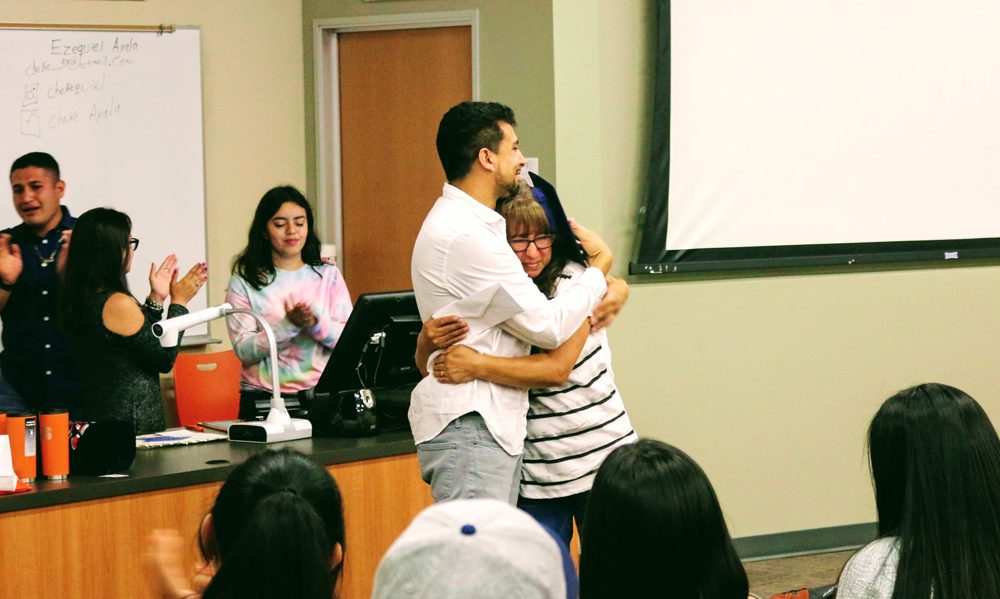 Greg Contreras (left) hugs his mother Oralia Contreras during the graduation ceremony of the Oregon Migrant Leadership Institute summer program in July 2018. (Submitted photo)
Greg Contreras (left) hugs his mother Oralia Contreras during the graduation ceremony of the Oregon Migrant Leadership Institute summer program in July 2018. (Submitted photo)
ONTARIO — On a hot summer day, boisterous high school students fill a classroom at the Treasure Valley Community College.
Amid their joyous chatter, Greg Contreras walks to the front of the room to tell a story – that, growing up, he didn’t think college would ever be an option.
“I was that student from a migrant family,” he began as he described the days working in the fields every summer during his middle school and high school years.
“With help from family and mentors, I changed my realities to go to college and earn a fulfilling career,” he said. “I know others can do the same.”
He’s telling his story as part of the Oregon Migrant Leadership Institute summer program that he spearheaded to serve students in the western Treasure Valley.
Oregon migrant education roots
The summer leadership program is made possible by the Migrant Education Program, which offers educational and social services to migrant worker families living in Oregon. The program, which has a regional office in Ontario, is popular among the western Treasure Valley migrant worker population. The program focuses on getting migrant students the help they need to succeed in school and prepare for college .
Farm work ranks among the most backbreaking, low-paying jobs in the United States.
According to the U.S. Department of Labor, most workers make between $10,000 and $12,500 a year, even though they often work overtime and face exposure to pesticides, heat, and frequent injuries.
According to the National Agricultural Workers Survey, children of migrant workers often work on farms after school or during summers, and drop out to stay in the fields.
Research suggests that migrant students often have the highest dropout rates of any demographic.
The federal government began tracking migrant students’ movements and outcomes in 1966 with the Migrant Education Program. Before that, more than 90 percent of migrant students dropped out of school nationwide. In 2017, 71 percent of Oregon migrant students graduated in four years, compared to 77 percent of non-migrant students.
The program, which is run by the U.S. Department of Education, provides money to states to ensure migrant students graduate high school or earn their GED to prepare them for college or employment. In Malheur County, around 1,807 students are involved with the program, which offers academic instruction, remediation, bilingual and multicultural instruction, career counseling and guidance, health services and preschool education.
To qualify, students must cross school district lines every three years with a parent who intends to work in seasonal or temporary agriculture, fishing, timber or dairy production, according to an email from Jonathan Fernow, migrant specialist at the Oregon Department of Education. Oregon’s program, which has 19 district offices that serve 19,500 students, focuses on math, graduation, reading, and school readiness.
The program is particularly welcome in Malheur County, one of the poorest counties in Oregon, whose robust agricultural industry makes it a draw for migrant workers.
More than 9,000 of the valley’s 31,000 residents are migrant seasonal laborers who work mostly in onion, potato and sugar beet harvesting, according to a June 2018 by the Oregon Housing & Community Services Department. But that number might be actually higher.
Every year, the Ontario branch of Oregon’s migrant program, which receives $900,836 per year, serves 895 students in eight schools in the Ontario and Annex school districts.
Most students are of Latino descent, but there’s a growing number of Middle Eastern families. Each district office must report data on their students’ movements and track behavioral issues, grades, and attendance rates.
In the Ontario School District’s program, employees — including a parent specialist, preschool specialist, graduation specialist and recruiters— retain relationships with hundreds of migrant worker families, school administrators and teachers. They offer everything from academic guidance, counseling, parent-teacher meetings, to a program that helps teachers and school districts better educate students who come from farm worker backgrounds.
The employees work long hours, often on weekends and evenings, engaging families. They also make sure families attend events and tutoring sessions.
Migrant heritage
Greg Contreras’ mother, Oralia Contreras, appreciates the aid the program provided her son. Last summer, Contreras invited her to attend the last day of the Oregon Migrant Leadership Institute, where he honored her.
Born and raised in Nyssa, Oralia Contreras started working in the farms alongside her father when she was 12 years old. Oralia got a taste of the migrant farm life when she met her husband, Gregorio Contreras, whose family would often travel between Texas and the Treasure Valley during harvest season. She said she and her husband would take their two oldest sons, Greg and Adam, to Texas during the winter months to work in the oil fields. But the family stopped traveling to Texas when Greg was 6. Oralia continued to work in the fields during onion, mint, corn and beet harvest, which is why she pushed her kids to do well in school.
“I always told them that, “Look, if you don’t want to grow up to be like your parents and do hard labor, go to school,’” Oralia said.
She said her three sons and daughter got a taste of what working in the fields was like when they were growing up.
“I wanted them to know what it was like, so I got the boys to start working when they were in middle school,” she said. Oralia said her parents depended on her and her nine siblings to bring money in to the household.
Now, Oralia’s son mentors other migrant students as the College Assistance Migrant Program director at Portland Community College and leads the migrant leadership summer camps in Ontario.
Last year, Contreras served 150 students who participated in the summer program, which was developed with the Ontario School District and the state’s Migrant Education Program.
The program “provides experiences to learn about their migrant history, to understand the role being migrant has played in their life,” said Contreras about summer camp.
As a result, Contreras said, students felt more confident about searching for financial aid, building relationships with teachers and counselors, and considering internships and volunteer opportunities.
This summer, he plans to host the leadership camp at the Treasure Valley Community College campus, where participants can live in the dorms and be immersed in a college atmosphere — a particularly valuable experience, given that nearly all the students would be first-generation college attendees.
Contreras said he plans to bring in 152 students from the Ontario and Nyssa school districts. The student populations at those schools, much like the surrounding region, are roughly 50 percent Hispanic. Some are young Mexican immigrants, but many were born in the U.S.
Often their parents grew up with little education and took the kind of low-wage jobs in the fields, which has made the Treasure Valley one of Oregon’s most productive agricultural areas.
He said many of his students’ situation mirrors his own family’s history.
“In my youth, I attended the Migrant Head Start Program in Nyssa,” said Contreras. “My parents would drop me off at the Head Start before going to work in the fields. From a young age, I was identified as migrant. As I grew, I started working in the fields alongside my mom and grandpa every summer.”
He said he wants all his students to understand how much they can achieve, despite the stigma of being the child of a migrant worker.
“You were viewed as poor, uneducated, incapable of accomplishing anything other than working in the fields,” said Contreras, who started working in the fields when he was 13 years old.
He said, today, he is passionate about using his story to inspire other migrant students and families to “aim high in life” and to “believe in a better future and take steps toward achieving their goals through education and leadership.”
“I hope the migrant students grow up to believe in themselves, to know they have the potential to make their dreams come true. They have the work ethic and perseverance to become amazing leaders, doing their part to improve their community,” Contreras said. “My hope is that they grow up to become confident, resourceful individuals who are empowered to make something positive of their lives, and to develop a habit of giving back to others.”
Reporter: Kristine de Leon: [email protected] or 541-473-3377.




